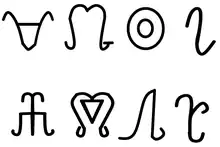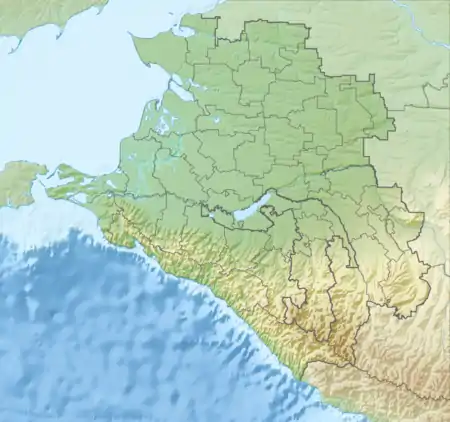Хьатыкъуайхэр, Хьатыкъоехэр | |
|---|---|
 Family symbols (tamigha) of some Hatuqway families | |
 | |
| Total population | |
| 5.650 (estimate) | |
| Regions with significant populations | |
| 5.000 (estimate) | |
| 200 (estimate) | |
| 200 (estimate) | |
| 100 (estimate) | |
| 100 (estimate) | |
| 50 (estimate) | |
| Languages | |
| Adyghe, Turkish, English, Arabic, Hebrew | |
| Religion | |
| Islam | |
| Related ethnic groups | |
| Other Adyghe tribes | |
| Part of a series on the |
| Circassians Адыгэхэр |
|---|
 List of notable Circassians Circassian genocide |
| Circassian diaspora |
| Circassian tribes |
|
Surviving Destroyed or barely existing |
| Religion |
|
Religion in Circassia |
| Languages and dialects |
|
| History |
|
Show |
| Culture |
The Hatuqway[1] (Adyghe: Хьатыкъуай, romanized: Hatıqway; Turkish: Hatukay; Arabic: حتوقاي, romanized: Hatuqway; German: Hatkoj; Russian: Хатукай, romanized: Khatukai) are one of the twelve major Circassian tribes, representing one of the twelve stars on the green-and-gold Circassian flag.[2][3] They were known for their art of war as a warrior tribe. After the Russo-Circassian War, their presence in the Caucasus was destroyed during the Circassian genocide, and their number was significantly decreased and today they exist only in small communities in various diasporas, and their names are not mentioned anymore in Circassian dialectology.[4]
History and etymology
History
The Hatuqway were a western Circassian tribal princedom whose homeland lay along the banks of the Kuban River. The Hatuqway people lived mostly in the mountains between the lower valleys of the Pshish River and the Belaya River.[5] Due to their small size and closeness to Temirgoy tribe, they were considered as one of the subgroups of Temirgoy. Their neighbours were Bzhedug (West), Abadzekhs (South) and, naturally, Temirgoys (East).
In the time before the Russian invasion, the Hatuqway were known as a powerful and warlike tribe that fought many wars mostly against the Crimean Tatars.
Turkish explorer Evliya Çelebi compiled the oldest detailed description of the Hatuqway tribe, he wrote:

Hatuqway province... The name of their prince is Jangiray, or Janbe Giray. This Hatuqway prince is rich, he owns many animals and eight thousand armed soldiers. Since this province was a large, fertile and beautiful homeland, its people slaughtered the son of the king of Moscow and bravely fought against the infidel Kalmyks. They are very loyal, savvy, armed and valiant soldiers. Even among the Circassian tribes, the villages are hostile to each other. So there is no shortage of constant internecine wars and strife. Nevertheless, they, communicate and trade with each other. And beyond the mountains live Abkhazians. In general, all the Abkhaz tribes are hostile towards these nomadic Circassian tribes. So, in the end, they do not have a single day free from battles and clashes – every day enemies come from different directions.
In the whole world, there are no such beauties worthy of praise and love like this people. Also there are purebred Arabian horses here. They are famous in the mountains: martens, similar to sables, wild cats, wild chickens, partridges.
They have no temples, no shopping malls and bazaars, no inns and baths. All wanderers and travelers stay with them for the night. And if you are staying as a guest in someone else's home, you will not be harmed. No matter how enemy you are for the owners, all the same, the owner of the camp, together with the neighbors living nearby, will do everything only for your well-being. You will not be blamed for a single mistake. If you ask your owner of the camp or the owner of the house for a chicken, he will show diligence, take a loan; if only he realizes that you need something, he will certainly do everything for you. If you are going to leave feeling embarrassed in something, he will give you, as if the whole world is in his hands.
I wrote and spoke very well in all one hundred and forty-seven languages, but I could not write this Circassian language, which is like a magpie shout.
After Imperial Russia's conquest of the Caucasus in the 1860s the tribe's homeland was occupied, and its members were scattered among the other Circassian tribes, resulting in the Hatuqway effectively ceasing to exist as a separate entity.
Today, the Hatuqway have several villages in various diasporas. The Hatuqway dialect is one of the Circassian languages in big danger of extinction.
Etymology
The widely accepted theory is that the names derives from Prince Inal the Great's son Temruk's son Hatko, who was prince of the Taman Peninsula. His principality is called Hatuqway (Place of Hatko) and the people of the principality are described as "From Hatuqway". Thus the name of the principality became the name of the tribe.
Another outdated theory about the origin of the name 'Hatuqway' is that it is from Хьаты ("Hatti") + Къуэ ("son"); meaning "Hattic son". 'Hatti' is an ancient name, originally referring to a non-Indo-European people of ancient Anatolia. Some researchers have claimed there may be links between Circassians and Indo-European-speaking communities,[6] and some have argued that there are connections between Circassians and Hatti, who are from ancient Anatolian peoples,[7][8][9] but these theories have not been addressed further and are not widely accepted. This Circassian tribe may preserve this name. This name also occurs elsewhere in the Caucasus in a Nart saga wherein the hero Batraz is said to speak in Hattic.
Culture and language
Culture
Traditional Hatuqway culture is part of the Circassian culture. The Hatuqway were engaged in agriculture, cattle and horse breeding. Before Islam, the Hatuqways worshipped Jesus as well as the gods of Circassians such as Shibla (god of lightning and thunder), Sozeresh (god of fertility), Yamish, Ahin and Hakustash.
Language
The Hatuqway speak the Hatuqway dialect of Adyghe, which is in the Circassian language branch of the Northwest Caucasian Languages. Nowadays, the number of speakers of this language has decreased considerably and it could not find a place in the literary language as there is no Hatuqway left in the Caucasus.
Hatuqway villages and families
Some Hatuqway villages in Turkey
Some Hatuqway villages (Adyghe: къуаджэ, romanized: quadjə) in Turkey.
| Province | Adyghe name | Romanisation | Turkish name | Source |
| Kayseri | Къэйнэр | Qəynər | Kaynar | [10] |
| Kayseri | Чэчэнэй | Çəçənəy | Beserek | [11] |
| Kayseri | Лакхьэблэ | Lakhəblə | Tersakan | [12] |
| Kayseri | Лыбыйхьэблэ | Lıbıyhəblə | Kavak/Kavakkköy | [13] |
| Kayseri | Мэлак | Məlak | Malak/Malakköy | [14] |
| Kayseri | Пэдысэй | Pedısəy | Akören | [15] |
| Kayseri | Хаджыисхьакъ | Xacıyishaq | Demirciören | [16] |
| Bolu | Пэциехьэблэ | Pətsiyeheblə | Elmalık | [17][18] |
| Bilecik | Хьатыкъуае | Hatıquaye | Poyra | [19] |
| Bilecik | Адыгэчэпни | Adıgəçəpni | Çerkesçepni/Yeniçepni | [20] |
Some Hatuqway clans in Turkey
Some of the Hatuqway clans (Adyghe: лъакӀо, romanized: tlak'o) in Turkey.
| Adyghe name | Turkized | Anglicised | Russianized |
| Бзадж (Bzadj) | Bzac | Bzaj | Бзаджов (Bzadzhov) |
| Джэндар (Djəndar) | Candar | Jandar | Джандаров (Jandarov) |
| Иуаныкъу (Yiwanıqu) | Yivanuk | Yiwaneqo | Иваников (Ivanikov) |
| Къокӏасэ (Qok'asə) | Koçase | Kochase | Кочесеко (Kocheseko) |
| ЛӀымафэкъо (L'ımafəqo) | Lımafko | Lmafqo | Тлимафов (Tlimafov) |
| МэфэшIукъо (Məfəṩ'uqo) | Mafeşuko | Mafeshuqo | Мафошов (Mafoshov) |
| Пэдыс (Pədıs) | Pedıs | Padis | Падисов (Padisov) |
| Такъырыкъо (Taqırıqo) | Takırıko | Taqereqo | Такириков (Takirikov) |
| Шэджэрыкъо (Ṩəcərıqo) | Şacerıko | Shajereqo | Шегероков (Shegerokov) |
| Жьанэ (Janə) | Jane | Zhaney | Жанев (Žanev) |
| Мастыр (Mastır) | Mastır | Mastir | Мастиров (Mastirov) |
| Шъобае (Ş̂obaye) | Şobaye | Shobaye | Собаев (Sobaev) |
| Хьатыкъо (Hatıqo) | Hatıko | Khateqo | Хатиков (Khatikov) |
| Хьапае (Hapaye) | Hapaye | Khapaye | Хапаев (Khapaev) |
| Утыж (Wutıɉ) | Vutıj | Wutij | Утижов (Utijov) |
| Еутых (Yewtıx) | Yevtıh | Yewtekh | Еутыхов (Eutykhov) |
| Брыдж (Brıdj) | Brıc | Brej | Бриджов (Bridzhov) |
| Чыназыр (Çınazır) | Çınazır | Chinazir | Чиназиров (Chinazirov) |
| Нэжъ (Nəĵ) | Nej | Nazh | Нажев (Nazhev) |
| ЛIышъхьакъо (L'ış̂haqo) | Lışhako | Lshaqo | Тлишхаков (Tlishkhakov) |
| ЦIэгъош (Ts'əğoṩ) | Tseğoş | Tsaghosh | Цегошов (Tsegoshov) |
| Дэбракъыкъо (Dəbraqıqo) | Debrakıko | Dabraqiqo | Дебракиков (Debrakikov) |
| Бэрзэдж (Bərzədj) | Berzec | Barzej | Берзеков (Berzekov) |
| Иуныхь (Yiwnıh) | Yivnıh | Yiwnih | Юнихов (Yunikhov) |
| Къалэбатэ (Qaləbatə) | Kalebate | Qalebate | Калибатов (Kalibatov) |
| Хьэбатыр (Həbatır) | Hebatır | Khabatir | Хабатыров (Khabatirov) |
See also
References
- ↑ Peoples of the USSR: An Ethnographic Handbook. Taylor & Francis. 2017. p. 79. ISBN 978-1-315-47540-0. Retrieved 20 July 2018.
- ↑ Cunningham, B. (1977). The New Jersey ethnic experience. W. H. Wise. p. 108. Retrieved 20 July 2018.
... or Pontic branch, consisting of Abkhaz, Ubykh, and Circassian proper (or Adyghe). The Circassians themselves are divided into some fifteen different clans, including the Abadsakh, Besliney, Bjedoogh, Hatukay, Kabardey, Kamurggoi, Shapsoogh, and Ubykh.
- ↑ "Circassians". Adiga-home.net. 2010. Archived from the original on August 20, 2014. Retrieved 17 May 2016.
The 12 Circassian tribes: Abadzeh Besleney Bzhedug Yegeruqay Zhaney Kabarday Mamheg Natuhay Temirgoy Ubyh Shapsug Hatukay. The twelve stars on the Adyghe Flag also refers to the twelve tribes.
{{cite web}}: CS1 maint: unfit URL (link) - ↑ Papşu, Murat (2013-06-10). "Çerkes dillerine genel bir bakış Kafkasya ve Türkiye". Archived from the original on 2013-06-10. Retrieved 2021-01-17.
- ↑ "Atlas of Caucasian languages (a pdf file)" (PDF). Archived from the original (PDF) on March 10, 2006.
- ↑ Serbes, Nahit (2012). Yaşayan Efsane Xabze. Phoenix Yayınları. ISBN 9786055738884.
- ↑ "Hititlerle Çerkezler Arasında Dil Benzerliği". 2003. Archived from the original on 8 December 2018.
- ↑ Çurey, Ali (2011). Hatti-Hititler ve Çerkesler. Chiviyazıları Yayınevi. ISBN 9786055708399.
- ↑ Prof.Dr. ĞIŞ Nuh (yazan), HAPİ Cevdet Yıldız (çeviren). Adigece'nin temel sorunları-1 Archived 2013-04-20 at the Wayback Machine. Адыгэ макъ,12/13 Şubat 2009
- ↑ "Kaynarlılar bir araya geliyor". Nart Ajans (in Turkish). Archived from the original on 18 April 2013. Retrieved 3 October 2018.
- ↑ "Beserek". Nisanyan Yeradları.
- ↑ "Tersakan". Nisanyan Yeradları.
- ↑ "Kavak". Nisanyan Yeradları.
- ↑ "Malak". Nisanyan Yeradları.
- ↑ "Akören". Nisanyan Yeradları.
- ↑ "Demirciören". Nisanyan Yeradları.
- ↑ "TÜRKİYE'DEKİ ÇERKES KÖYLERİ". www.circassiancenter.com. Archived from the original on 24 September 2012. Retrieved 3 October 2020.
- ↑ "Elmalık". Nisanyan Yeradları.
- ↑ "Poyra". Nisanyan Yeradları.
- ↑ "Yeniçepni". Nisanyan Yeradları.